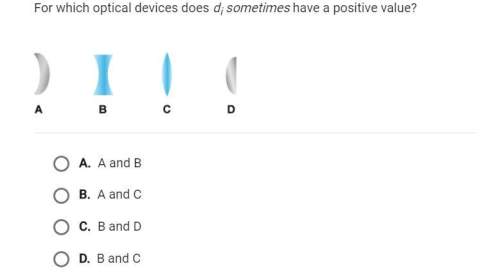
Physics, 06.03.2020 23:57 wendelljo61
The near point (the smallest distance at which an object can be seen clearly) and the far point (the largest distance at which an object can be seen clearly) are measured for six different people.
near point (cm) far point (cm)
Avishka 40 infinity
berenice 30 300
chadwick 25 500
danya 25 infinity
edouard 80 200
francesca 50 infinity
a. Which, if any of these people are nearsighted (myopic)?
b. Which, if any, of these people require bifocals to correct their vision?
c. Which, if any, of these people's vision can be corrected using only converging lenses?

Answers: 1


Another question on Physics

Physics, 21.06.2019 17:00
What would the difference of spectral lines emitted by hydrogen gas in distant galaxies which is normally found at a wavelength of 21 cm on earth, be observed at 21.1 centimeters?
Answers: 2

Physics, 22.06.2019 18:00
Cells in the nervous system have a potential difference of 70 mv across the cell membrane separating the interior of the cell from the extracellular fluid. this potential difference is maintained by ion pumps that move charged ions across the membrane. is this an emf? select the correct answer and explanation. 1)no. the ion pumps cannot separate charges; thus, they cannot create a potential difference. 2)yes. the ion pumps cannot separate charges, but they still can create a potential difference. 3)yes. the ion pumps can actively separate charge; thus, they can create a potential difference. 4)no. the ion pumps can separate charges, but they cannot create a potential difference.
Answers: 1

Physics, 22.06.2019 23:00
Acommon technique in analysis of scientific data is normalization. the purpose of normalizing data is to eliminate irrelevant constants that can obscure the salient features of the data. the goal of this experiment is to test the hypothesis that the flux of light decreases as the square of the distance from the source. in this case, the absolute value of the voltage measured by the photometer is irrelevant; only the relative value conveys useful information. suppose that in part 2.2.2 of the experiment, students obtain a signal value of 162 mv at a distance of 4 cm and a value of 86 mv at a distance of 5.7 cm. normalize the students' data to the value obtained at 4 cm. (divide the signal value by 162.) then calculate the theoretically expected (normalized) value at 5.7 cm.
Answers: 2

Physics, 23.06.2019 00:30
Discuss the difference between thermal energy and heat. (terrance) terrance, egolf, r., congdon, donald. physical science student text, 5th edition. bju press, 2014. vitalbook file.
Answers: 1
You know the right answer?
The near point (the smallest distance at which an object can be seen clearly) and the far point (the...
Questions




Mathematics, 27.09.2019 23:30

Medicine, 27.09.2019 23:30



Mathematics, 27.09.2019 23:30

Mathematics, 27.09.2019 23:30

Biology, 27.09.2019 23:30

English, 27.09.2019 23:30


Health, 27.09.2019 23:30

English, 27.09.2019 23:30


Physics, 27.09.2019 23:30

History, 27.09.2019 23:30

Health, 27.09.2019 23:30


Mathematics, 27.09.2019 23:30




